|
THOMAS HART - THE HERO RETURNED FROM BOSTON

John Singleton Copley, CC0, via Wikimedia Commons
General Thomas Gage
Displaying the
Masonic hand sign of
faith |
- General Thomas Gage (c.1718-1787) was commander of the
British troops in North America.
- He saw action with George Washington in the French and Indian War, where Gage served alongside his future opponent in the 1755 Battle of the Monongahela.
- He was the first British general whose career was wrecked by the American Revolutionary War, which would ruin the careers of William Howe, John Burgoyne, and Henry Clinton, each in turn.
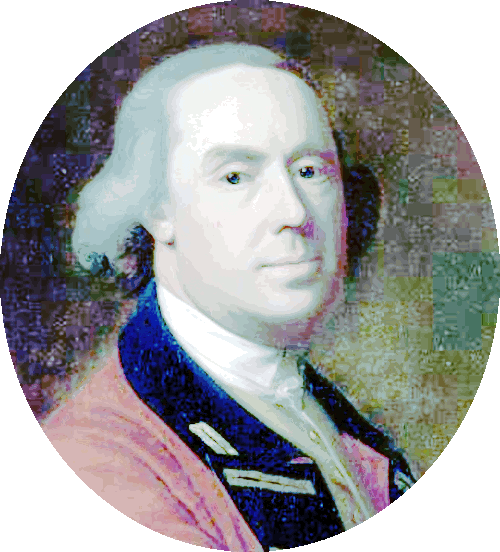
General Thomas Gage
with the lights on |
- Gage had risen quickly in the ranks after he came to America
as a lieutenant, he was promoted to colonel in 1758, and was a major general by 1761.
- In the early days he was quite popular on both sides of the
ocean.
- He was acting commander in chief of British forces in North America in 1763 and officially succeeded Amherst in that role in 1764.
-
From 1763 to 1775, he served as commander-in-chief of British forces in North America, overseeing Britain's response to the outbreak of Pontiac's War in 1763.
|
Of the principle British commanders in America, only Charles, Lord Cornwallis—humiliated at Yorktown—salvaged his career. (americanrevolutioninstitute.org)
|

Redcoat |
- Gage maintained communications with the governors of every colony in North America and several West Indian islands,
and he handled his vast and varied administrative responsibilities with skill.
- In 1770 he was promoted to lieutenant general
and he was widely admired, both in America and Britain.
-
He purchased thousands of acres in New York and New Brunswick
for his growing family.
- Gage took a leave of absence in
1773 to return to England, however, during that year, America was in
crisis.

Bannerman Catalogue
1949
84th
anniversary |
- The Crown sent him back to America not only as commander in chief but also as royal governor of Massachusetts charged with implementing Parliament’s punitive measures against that colony.
-
These were knows as the Intolerable Acts punishing
Massachusetts for the Boston Tea Party that occurred on
December 16, 1773.
- It was in response to extremely
complex tax and parliamentary representation issues so it
needs to be studied because there's a lot more to it than the
patriots were mad about the Stamp Act and threw the tea
overboard.
- Some of the patriots who took part in the Tea
Party disguised themselves as Mohawk indians and they
destroyed a whole shipment of tea, 92,000 pounds or 340 tea
chests, from the East India Company.
- This was seen as an
act of treason by the British government.
|
The "Intolerable Acts," or Coercive Acts, were a series of British laws passed in 1774 to punish the colony of Massachusetts for the Boston Tea Party. Intended to punish Massachusetts and reassert British control, these acts included closing the port of Boston, altering the Massachusetts government to increase royal authority, allowing British officials to be tried elsewhere, and changing the Quartering Act to allow soldiers to be housed in unoccupied buildings at colonial expense. Instead of isolating Massachusetts, the acts unified the colonies in opposition to British rule and led to the First Continental Congress. (Assistant)
|
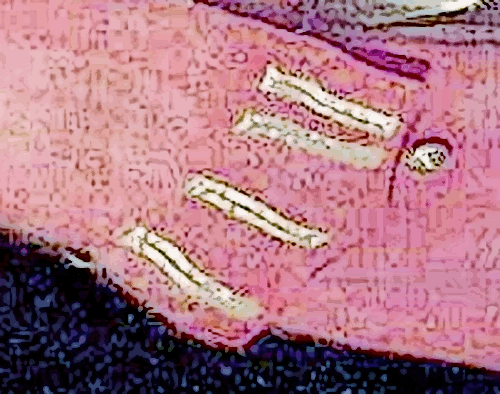
Taxation without
representation |
- The biggest point of contention was the tea itself
because of competition between Britain and America about who
would get the best prices and additionally, there was a lot
smuggled in that escaped taxation.
- This was an action that the
colonists did not want the British to find out about nor to
stop because the tea was less expensive.
- In some respects the new laws the king enacted were
very brutal such as requiring colonists to house British
soldiers in their homes.
-
Within a year Gage's career unraveled because the military occupation of Boston infuriated the colonists and fueled resistance.

The British are
coming |
- As a result, a force that Gage sent to Concord in April to seize weapons stockpiled by the resistance was
trampled by militia.
- Gage’s military force was wholly inadequate to suppress the insurrection.
- This sparked the Battles of Lexington and Concord and the
beginning of the Revolutionary War.
- There was no official
colonial army, but there were many small patriot militias,
especially in New England and they were building up their
ammunition stores.

Not a hero's return |
- It went down in history that General Gage did not want a
war, he wanted to peacefully confiscate the ammunition.
-
That's the story.
- Although he had petitioned Parliament
several times to send more troops to calm the militias!!
- It was on April 19, 1775, that Paul Revere took his
famous ride.
- Not long after Gage received orders to return to Britain
and it was not a hero's return, although General Sir William Howe,
his replacement,
did not blame him for what happened.
- At that point the
Gages returned to England.
|
Scapegoat |
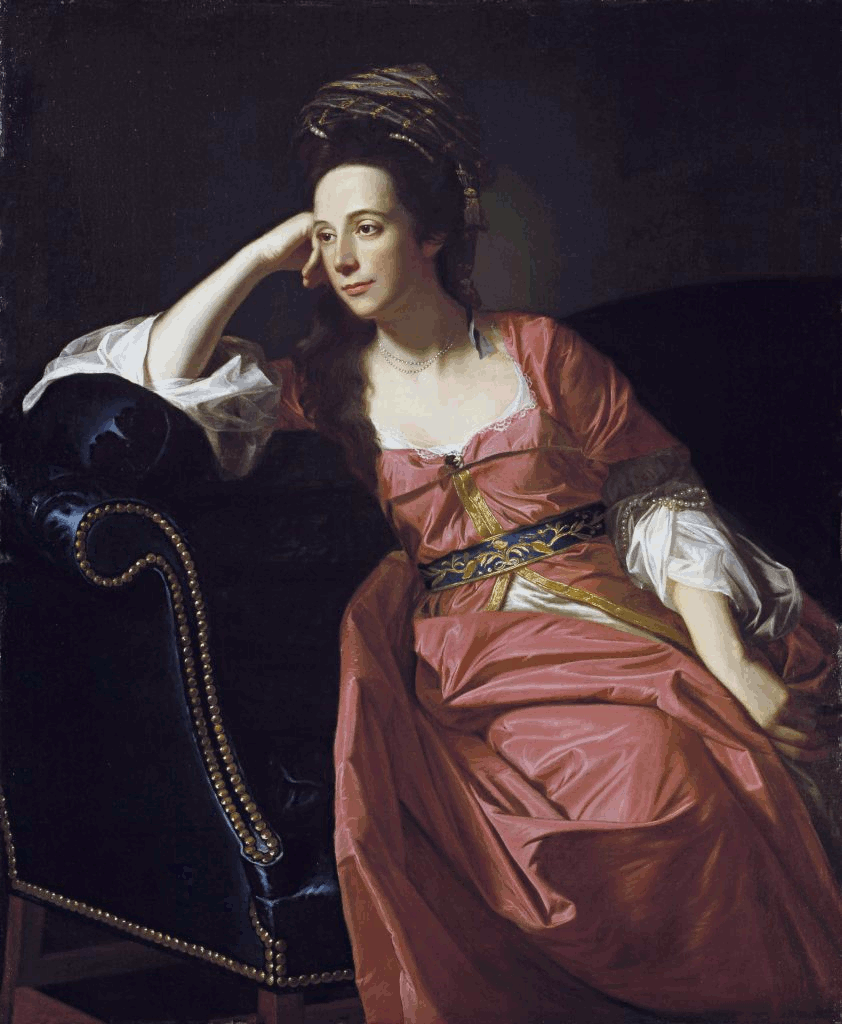
John Singleton Copley, Public domain, via Wikimedia Commons
Margaret Kemble
Gage 1771 |
- In 1758 Gage married Margaret Kemble (1734–1824), the beautiful daughter of a wealthy merchant,
Peter Kemble.
- The wedding ceremony took place at her father's 1200-acre Mount Kemble Plantation in New
Jersey.
-
Apparently this portrait of Margaret in 1771 was considered sexually suggestive
without being lewd because it resembled an Ottoman court (and
harem) as her outfit, a turquerie, is like loose fitting
pajamas.
- Artist John Singleton Copley (1738–1815) described it as 'beyond compare the best
ladies portrait' he had ever drawn.
|
Copley painted Mrs. Gage in 1771 in a languid pose
wear wearing an iridescent Turkish style caftan over a
lace trimmed chemise with an embroidered belt at her
waist. Pearls and a turban-like swath of drapery adorn
her hair. This style, known as turquerie, was the
height of fashion for masquerade balls in Europe, but
was largely unknown in British America, where women
had no opportunity to wear such attire, which was
intended to suggest the costumes worn by Turkish women
in the Ottoman court. (americanrevolutioninstitute.org)
|
- Some believe the hero in this Thomas Hart cartoon
resembles the British General Thomas Gage.
- Some think the woman with the hero in the cartoon resembles
his wife Margaret, and
much more so than it resembles Gage.
|
It was a style western Europeans imagined was fashionable in the sultan’s harem, a symbol of Oriental luxury and vice. (americanrevolutioninstitute.org)
|

Turban |
- Margaret Kemble's father arrived in New York around 1730 and settled in New Jersey, where he quickly established himself as a merchant and became the largest landowner in Morris County.
- His first wife, Gertrude Bayard (1701-1745), Margaret’s mother, made Margaret a cousin to the de Lanceys, van Courtlands,
the Van Rensselaers and other prominent New York families.
- Margaret was recognized in New York society for her beauty
and self-assurance and she was seen as the perfect wife for a General.
- She was called 'the Dutchess' by her husband's military
subordinates and the two were rarely apart.
- She had been
born into an American family but they were British Loyalists
and it was known that she had said that she hoped her husband
would not kill her American compatriots.
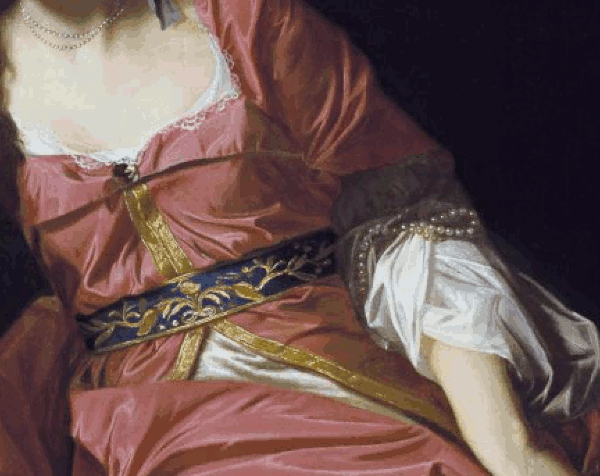
Beyond compare |
- The Gages liked her portrait so
much they took it to London where it created a 'mild'
sensation when it was placed on exhibition in 1772.
- After
they returned to America, the painting remained in England and
was placed at the Gage estate known as Firle Place in East
Sussex where it hung over the fireplace.
- The estate is a
historic manor house located outside London and has been
owned by the Gage family for over 500 years.
- The
portrait hung there until 1984 when the Putnam Foundation was
able to purchase it for the Timken Museum of Art.
- This is also
the estate to which the couple returned and where their 11
children were raised.
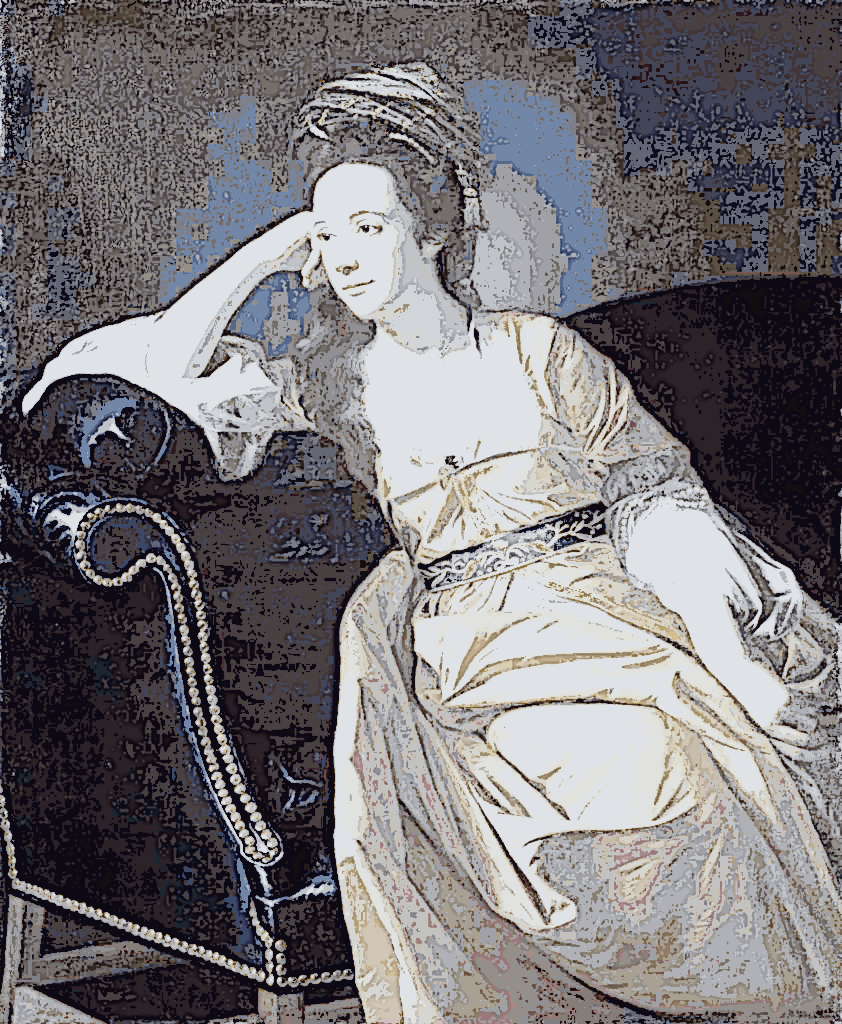
Exotic |
- The painter, John
Singleton Copley, played on the
fact that Margaret was known as a bit exotic
and he later said it was the 'finest portrait of a Lady' he
had ever done and it delighted him.
- Margaret Kemble was one quarter English, one quarter Greek, one quarter Dutch, and one quarter French.
- Her father was born in Smyrna, a Greek
enclave on the Turkish coast and was the son of an English merchant who traded with
the Ottoman Empire.
- Her grandmother was a Greek woman from the nearby island of Chios
which was a part of Turkey.
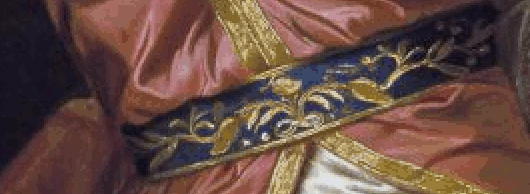
Dutch traders |
- Margaret was a descendant of Dutch and Huguenot parents.
- Huguenots were the French Calvinists who were persecuted by
the reigning Catholics at the time in France.
- Many of
them fled from France in the 1600s and migrated to Dutch New
Amsterdam, the original name of New York City where they had
religious freedom.
- She is a significant ancestor of
centuries of English nobility who have Dutch and Huguenot
ancestry from what was once New Netherlands. showing that
English nobility is not all that English.
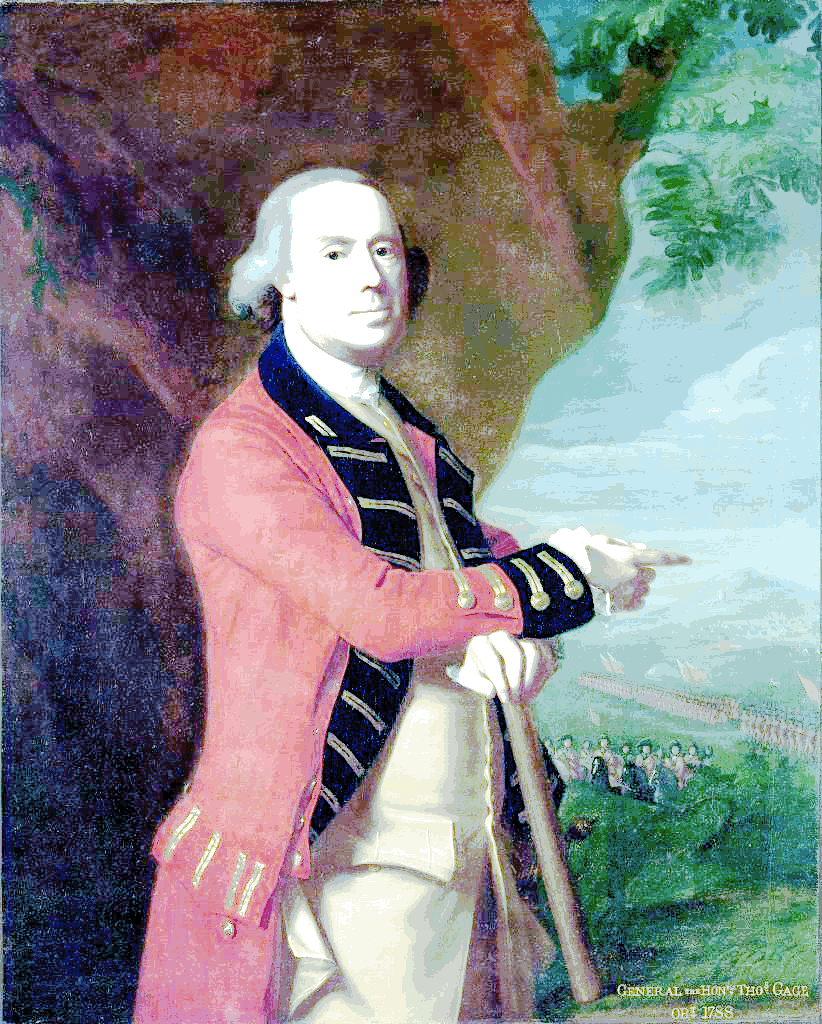
Dashing figure |
- When the couple married, Thomas Gage was already a
general and he was known as kind of a dashing figure,
socialable and likeable and Margaret was known as a real
beauty as a young woman.
- Together, they were very
entertaining and they spent a lot of time in New York City where
their main residence was, although they had periods they also
lived in Montreal and Boston.
- She was potentially a
person of divided loyalties with her American upbringing and
British husband.
- However, there was some division in her
family over the issue of British control of the American
colonies.

Realistic |
- Margaret's friends were critical of the portrait because
they thought she should have been more 'realistic.'
-
Perhaps having to do with some felt she was more beautiful in
the portrait than in real life, however, that could be the
result of the clothing she normally wore as a simple colonial
housewife.
- You can bet she wasn't wearing turbans around
as this portrays her as a 'sultana' or wife of a Muslim
sultan.
- As Mary Magdalene once was married to one,
and the Huguenots are the descendants of Magdalene.
- Its thought the
the clothing was provided by Copley as most artists had
extravagent wardrobes on hand for their patrons to 'dress up'
and the outfit was pictured in another of his portraits.
- Her faraway gaze signifies pensive thought and
intellectuality and it's her gaze that intrigues art
historians and those who see this painting.

Headquarters |
- After Gage's numerous appointments, they returned to
England in June 1773, presuming this would be their final
military destination and they would stay there for once and
for all.
- Thomas Gage was well-liked socially but in many
respects, he was considered weak by the British themselves.
- The couple missed the Boston Tea Pary in December of that
year.
- King George III responded by sending new orders for
Gage to return to America in May 1774.

Backwoods |
- Margaret returned to America with her husband in 1774,
against her husbands wishes, which was surprising because they
were known as a very happy, socialble couple.
- She arrived
later than him and came in through New York City, most likely
to visit her family in New Jersey.
- Margaret found that circumstances had changed
with the American general public.
- The general made his headquarters in Massachusetts as
the military governor to restore order, where Margaret had few acquaintances.
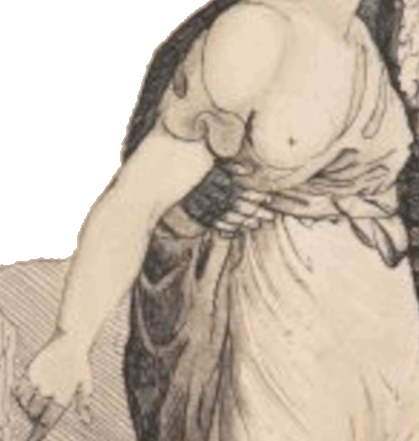
Scandalous |
- Relations between the colonists and the army degenerated
and some of her husband’s British subordinates found her American birth, self-confident manner, and
her 'out in the open' intimate relationship with their commander had become reasons to distrust her.
- Rumors went around that Margaret was sympathetic to the
American rebellion, despite the fact that her father was a loyalist,
and her brother was a major in the British army and deputy adjutant general.
|
So did many Massachusetts loyalists, to whom she was an exotic stranger. She was connected to all the best families in New York and navigated among them with skill and grace, but this meant little to the clannish loyalists of eastern Massachusetts. She was not one of them. (americanrevolutioninstitute.org)
|

No loyalty |
- Additionally, her husband was commander in chief of the king’s forces in North America.
- The rumors were circumstantial, there was no proof, but the idea went around that the army’s secrets were being betrayed by someone close to the general.
- Amd this would explain all the British losses, which seemed so inexplicable
to the troops.
- Everything from British soldiers cut down by colonial militia, trapped in Boston by provincials, impotent to suppress a colonial rebellion led by farmers.
|
The displaced governor, Thomas Hutchinson, noted that she had once said to him that “she hoped her husband would never be the instrument of sacrificing the lives of her countrymen,” but her husband probably shared that sentiment. The war was a tragedy for their family as it was for the empire. (americanrevolutioninstitute.org)
|

Dotage |
- With Boston under siege, beset by food shortages and disease and filled with hundreds of wounded soldiers mangled in battle, Gage put Margaret on a ship bound for England in August 1775.
- She suffered a horrible journey back to England with
all the sick and wounded.
- Rumors about disloyalty
proceeded her to London where it was taken very seriously.
- Second hand statements about her loyalty that were not even acknowledged by
the person who had said them went around.
- Everyone believed that Gage was so smittrn with Margaret
that she had him 'infected with connbial dotage' and he was
under her complete control.

Scorned |
- The
rumors were so firmly committed that the cause of the British
failure was Margaret's fault, because she was somehow divulging their secrets.
-
She was somehow the reason the British army was trapped in
Boston.
- The hero story becomes some kind of Oriental
seduction and the cartoon shows her getting up (half nude) off
the sofa where she wraps herself around the general, taking
control, the embodiment of scandolous seduction and
corruption.

British forces in
Boston |
- General Gage, by then, the Governor of Massachusetts and commander of British forces in Boston, knew he had a limited time to act.
- He was under pressure from his superior, Lord Dartmouth, to take a swift and decisive action against the growing rebellion.
- However, Gage knew that he would first need proper
intelligence to act upon.
- Gage claimed that he received
an anonymous letter written in French that detailed the
precise number and location of artillery and supplies hidden
in Concord.
|
He sent two British Officers, Captain William Browne and Ensign Henry DeBerniere, to gather intelligence throughout the Massachusetts countryside while disguised as “country people.” In late February, Gage sent them to Worcester, and less than a month later, he turned his attention to another important community, Concord. (Thompson Dasher)
|
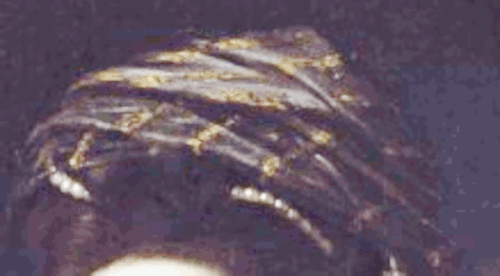
Anonymous woman
tarred and feathered |
- The two officers that Gage had sent to spy, dressed as
land surveyors, Browne and DeBerniere (debonair), met an anonymous
woman who directed them to the home of Daniel Bliss, a 'friend
to the government.'
- As they dined with Bliss, they were likely informed of the
huge quantity of cannon, powder, flour, fish, salt, and rice that they later reported to Gage.
- Soon after, the woman returned with tears in her eyes and
she was terrified.
- Men from the town had discovered what she had
unknowingly done, and threatened to tar and feather her if she
did not leave there.

Time to act |
- Bliss, a loyalist, was also
threatened and ordered to leave town so he left with the two
spies headed toward Lexington, never to be seen again.
- He
had apparently endured hostility from his neighbors for years
and no longer felt safe.
- Brown and DeBerniere reported the information to
Gage that he desperately needed, he knew it was time to act.

Expels Margaret |
- It wasn't long after General Gage heard all the rumors
and quickly sent Margaret away.
- Her relationship with her
husband was never the same again although they had 11 children
together.
- According to Paul Revere’s Ride, by David Hackett Fischer, the marriage of General Thomas and Margaret Gage didn’t survive the start of the Revolutionary War.
- The gossipers said he was governed by his wife and he didn't like
that opinion.
|
Before this fatal day, Gage had been devoted to his beautiful and caring wife. But after the Regulars returned from Concord, he ordered her away from him. Margaret was packed aboard a ship called Charming Nancy and sent to Britain, while the General remained in America for another long and painful year. (americanrevolutioninstitute.org)
|

Family tree |
- That estrangement, was caused by circumstantial evidence which strongly suggested that Margaret Gage leaked word to Dr. Joseph Warren about the march
of the British to Concord.
- It’s a
far-fetched theory that was seized on as fact.
- Margaret
accused of being torn between two loyalties, Warren or Gage,
or was the general betrayed by his closest companion who he
shared the military order with?
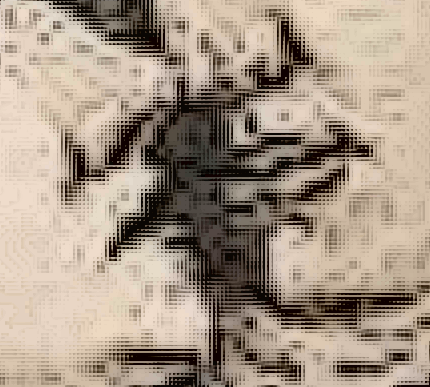
Rumored affair |
- There were even accusations about the possibility of an extramarital affair between the military wife and the widowed physician
Warren.
- Circumstantial evidence suggests that
Margaret may have played a key role in the lead-up to the first battle of the American Revolution (the Battle of Lexington and Concord).
- Knowing how we have all these shape-shifting demons
running our goverment, like Trump who played
Paul Revere Dick and the
Raiders, this all seems very suspicious.

Loose lips |
- Prior to the battle, the Sons of Liberty observed British troops in Boston preparing for action.
- The Sons of Liberty were behind the Boston Tea Party.
-
General Gage, as the British military commander in Boston, ordered the mission to seize colonial weapons in Concord
and to capture the rebel leader, Samuel Adams, leading to the Battles of Lexington and Concord in April 1775.
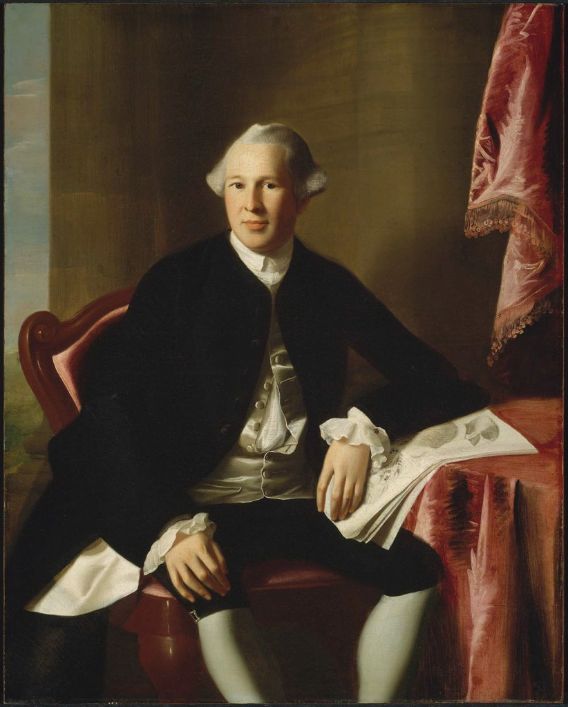
John Singleton Copley, Public domain, via Wikimedia Commons
Dr. Joseph Warren in
1765
Showing off
a Masonic hand sign |
- Joseph Warren (1741-1775), one of the key leaders of the Sons of Liberty, learned from a confidential informer, well-connected to the British high command, about plans to arrest Samuel Adams and John Hancock, who were
known to be at Lexington, and burn the colonists' military
stores at Concord.
|
The Sons of Liberty was a loosely organized,
clandestine, sometimes violent, political organization
active in the Thirteen American Colonies founded to
advance the rights of the colonists and to fight
taxation by the British government. It played a major
role in most colonies in battling the Stamp Act in
1765 and throughout the entire period of the American Revolution. Historians called the activities of the Sons of Liberty "mob terror." (Wikipedia)
|
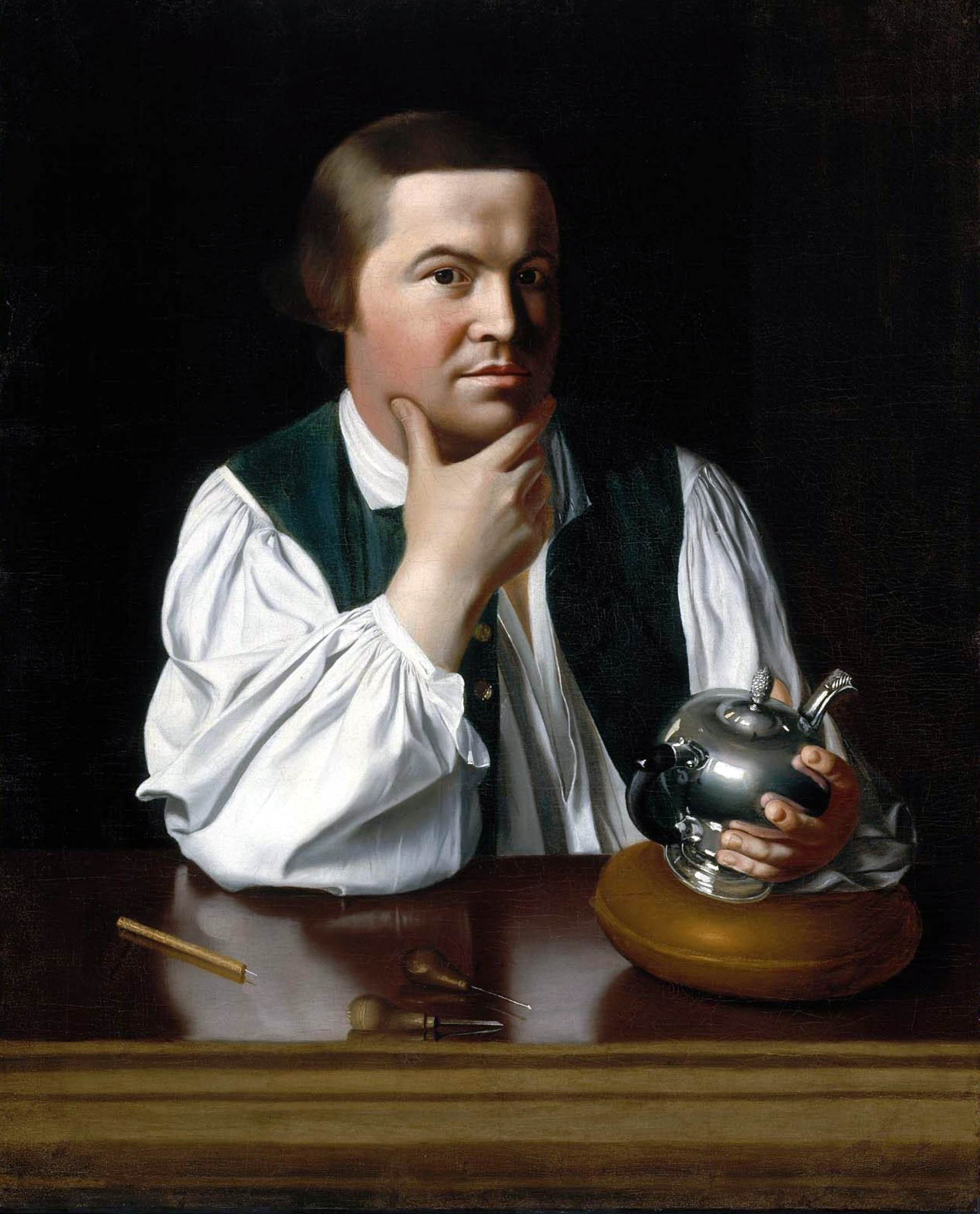
John Singleton Copley, Public domain, via Wikimedia Commons
Paul Revere in 1768
Displaying the
Masonic penalty pose |
- Warren, after learning of the plan, dispatched Paul Revere
(1734-1818) and William Dawes, which set off a chain reaction of
'alarm' riders across Massachusetts and into adjoining colonies.
-
After being tipped off about Gage's plans, Revere, along with William Dawes and Samuel Prescott, rode to warn the countryside of the approaching British regulars.
- Instead of a quiet night mission, the British troops were opposed by thousands of wide-awake, angry, armed colonists
and the British suffered 273 casualties while the patriots
suffered 93.
- General Gage, the British Commander-in-Chief, had intended to prevent a war, but was forced to send an additional 1,000 units to safely return the British force to Boston.
|
In response, Patriot leaders including Paul Revere dispatched riders, such as Revere, to warn the countryside, ultimately igniting the American Revolutionary War. Revere famously rode to spread the alarm about the approaching British troops. (Assistant)
|
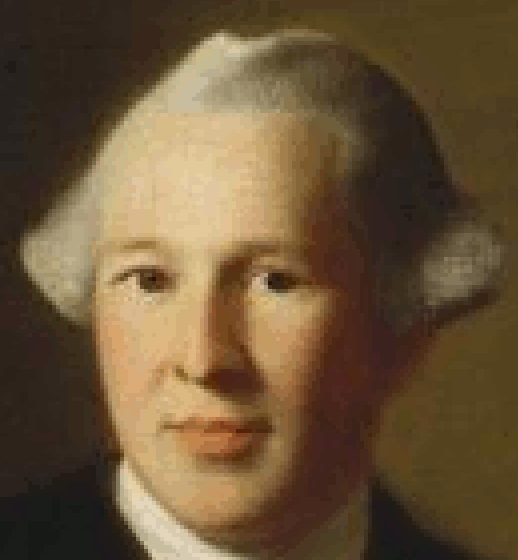
Warren |
- Warren's informant remains unknown and 2 months later, he was killed during the Battle of Bunker Hill
on June 17, 1775.
- Some historians feel that if he had
not died at Bunker Hill he would have been chosen as our first
president, instead of George Washington.
- Though the evidence is circumstantial, historians strongly suspect that the informant was Margaret,
except they have zero proof.

The Shot Heard 'Round the World |
-
General Gage stated later that he had only told 2 people of the plan, which was to be kept a
'profound secret': his second-in-command, and one other person.
- Some of the other top British officers suspected that
that other person was Margaret but they never had any proof.
- Gage knew that Samuel Adams and Joseph Warren were the 2
main leaders of the colonial resistance and he wanted both of
them caught.
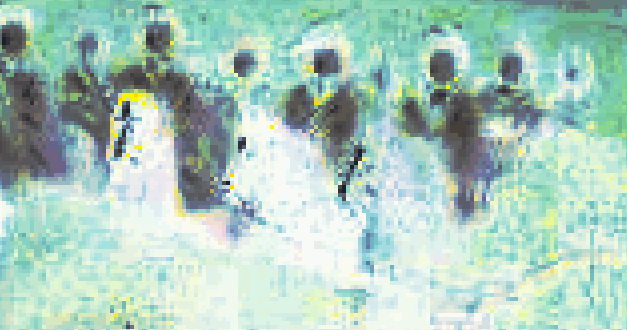
Lynch mob rule |
- Before the engagements at Lexington and Concord, General Gage had been known as a devoted husband, but a year afterwards,
Margaret sailed to England at least temporarily without him.
- So the question is, why was Margaret blamed for the
General's secrets he was not supposed to divulge and who did
he actually tell them to?
- There doesn't appear to be any
proof it was Margaret.

Up in the air |
- A clergyman from Roxbury, Massachusetts, named William
Gordon wrote that the spy was 'a daugthter of liberty
unequally yoked in the point of politics.'
- Many
historians have taken this as logically applying to Margaret
because she was sympathetic to the patriots and she was
unequally yoked to her husband, but is that really enough
evidence.
- Because of this, many historians have been
hesitate to draw a conclusion.

Murky |
- Margaret was sent to England in 1775 following the start of the American Revolution, likely due to suspicion that she was a spy for the American colonists.
- Some took her abrupt return to England as a sign of her
guilt although her children were there.
- Gage himself was
removed from the office of the governor of Massachusetts that
same year and returned to England on October 10, 1775,
following much criticism of his leadership.
- There is no
evidence the couple had an unhappy marriage.
|
If
you know your family history, which is not that hard
to do anymore, you might find that there are people
looking out at you from the portraits who knew your
family and who may or may not have been a friend of
your family. (Dr. Florence Gillman, Timken Museum of Art)
|
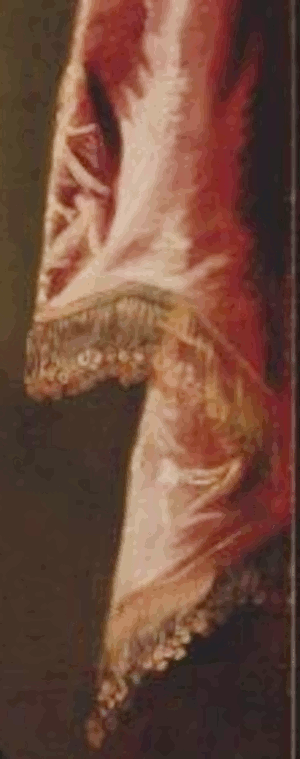
Veiled |
- She lived out the rest of her life in England, where her husband later joined her
although he died long before her in 1787, a short 4 years
after the end of the war.
- Margaret died in 1824, nearly 37 years after
her husband did
at age 90.
- While the theory that she spied on her husband is popular, some historians now argue the evidence is
completely circumstantial.
- So the next question is, what
was Gage up to, sounds like he wanted to start a war and he
did petition the government for more troops which they sent.
|
He said to his friend, “If the British march
By land or sea from the town to-night,
Hang a lantern aloft in the belfry arch
Of the North Church tower as a signal light, —
One, if by land, and two, if by sea;
And I on the opposite shore will be,
Ready to ride and spread the alarm
Through every Middlesex village and farm,
For the country folk to be up and to arm.”
(Henry Wadsworth Longfellow, The Midnight Ride of Paul Revere)
|
|
General
Thomas Gage as Paul
Revere |
General Thomas Gage
1718/9-1787
3/10
4/2 |
Paul Revere
1734-1818
1/1 5/10
Masonic penalty hand pose
|
 |
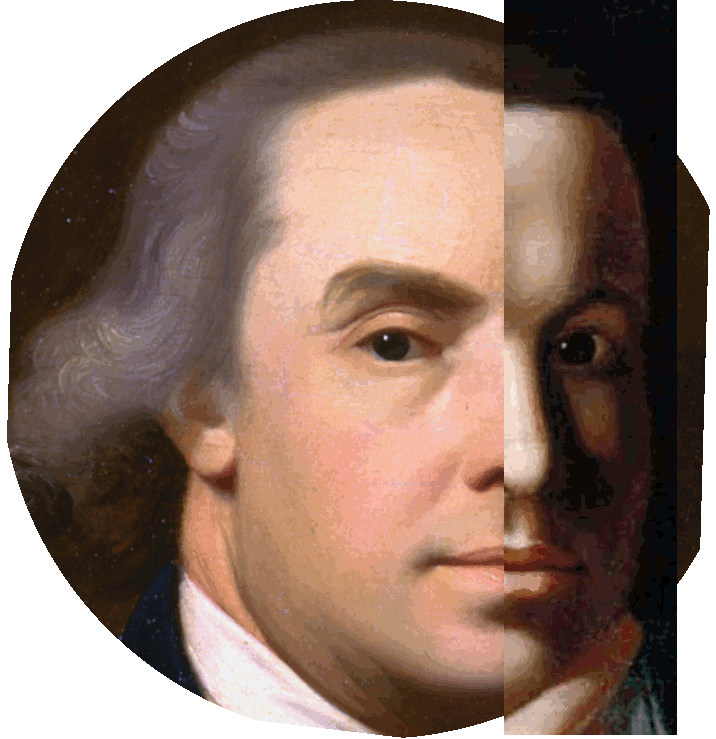 |
|
One if by land, two if by sea |
-
In 1774, the Boston Committee of Correspondence and the Massachusetts Committee of Safety employed Paul Revere as an express rider to carry news, messages, and copies of important documents as far away as New York and Philadelphia.
- On the evening of April 18, 1775, Dr. Warren summoned Revere and gave him the task of riding to Lexington, with the news that British soldiers stationed in Boston were about to march into the countryside northwest of the town.

Revere |
- Revere contacted an unidentified friend and instructed him to hold two lit lanterns in the tower of Christ Church (Old North Church) as a signal to fellow Sons of Liberty across the Charles River in case Revere was unable to leave town.
- The lanterns were a signal stating that the British troops planned to row
'by sea' across the Charles River to Cambridge, rather than march
'by land' out Boston Neck.
- It's important to note that
everything we know about the ride was handwritten by Revere in
his own words.
- That's all we have and that is what is in
the history books, his notes.

Quelling unrest |
- Now why would General Gage want to start a war, unless
he were a shape-shifter trying to keep us stuck here in
his lower ego.
- His main job in America was to quell
unrest, however, his order to march resulted in the first
shots of the Revolutionary War at Lexington and Concord.
-
Revere was captured but quickly released? Really?
- But
they did take his horse.
- Dick Cheney just died it's a
9/11.
|
LISTEN, my children, and you shall hear
Of the midnight ride of Paul Revere,
On the eighteenth of April, in Seventy-five;
Hardly a man is now alive
Who remembers that famous day and year.
(Henry Wadsworth Longfellow, The Midnight Ride of Paul Revere)
|

Honorable? |
- Once again, the woman seems to have been unfairly blamed
and her history defiled with zero proof, just the opinion of
mouth movers and gossips, plus plenty of the anti-female bias.
- But
notice, no one questioned the General about why he was
spreading national secrets around, and of course, no one
thought of ever doubting him.
- And do we really know if
Paul Revere was a patriot or really even existed, there are
many who claim their ancestors knew him.
- From what we are
now learning it appears likely he had (at least) two lives
going on at the same time.
- With
what we know, he does appear to be a shape shifter so he's
working against us right from the start.
|
So through the night rode Paul Revere;
And so through the night went his cry of alarm
To every Middlesex village and farm, —
A cry of defiance and not of fear,
A voice in the darkness, a knock at the door,
And a word that shall echo forevermore!
(Henry Wadsworth Longfellow, The Midnight Ride of Paul Revere)
|
- So what was really going on here, we know that the
Freemasons on both sides of the Civil War, Union and
Confederate were actually working together to instigate and
fuel the war.
- And that it was part of their
Knights of the Golden Circle plan to take over North and
South America and use them as slave states, and turn Havana,
Cuba, into the capital.
- There always seems to be
Freemasons involved in these plots.
|
For, borne on the night-wind of the Past,
Through all our history, to the last,
In the hour of darkness and peril and need,
The people will waken and listen to hear
The hurrying hoof-beats of that steed,
And the midnight message of Paul Revere.
(Henry Wadsworth Longfellow, The Midnight Ride of Paul Revere)
|
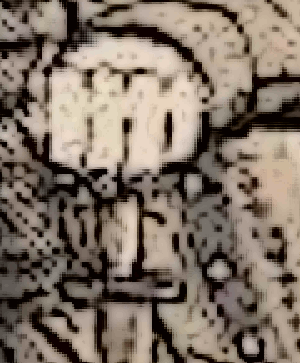
Hitler in World War
II |
- We also know that Fred Trump, a
Bavarian American, played the part of Hitler in World War II
and all kinds of other details, such as the demonic overpaid defense
contractors were building arms for both sides.
- They
claimed they were forced to, in order to make it 'fair.'
-
And then the whole Bannerman (Fred Trump) government
assistance program to arm the world against each other, but he
was a 'holy and religious' man.
- The haunted live again.
|
We were visual and fun and crazy and were America's answer to the British music invasion. ... We just happened to be at the right time and had the right name and had the right gimmick. (Paul
Revere Dick of the Raiders)
|
|
|
Pierced by a British musket-ball.
Henry Wadsworth Longfellow

|

